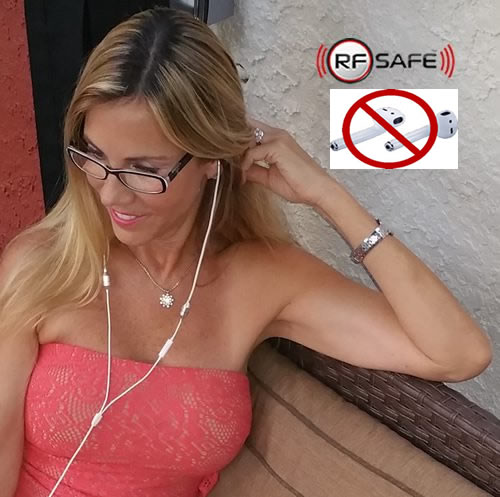Is Bluetooth Radiation Dangerous?
Bluetooth radiation has been even less studied than cell phone radiation. The lack of formal studies has enabled the ‘experts’ to claim that Bluetooth radiation is safe. This claim is based not on research proving Bluetooth radiation safe but rather on a lack of studies proving it unsafe, which is changing quickly.
On March 16th, 2016, a recent study on Antarctic krill found that navigation was disrupted by exceptionally weak radio-frequency fields. Research showing insect cell death from 6 minutes’ weak wireless exposure added to previous similar findings (a, b, c) on Bluetooth, etc. Everything hints at a need to monitor our fast-rising, non-ionizing Bluetooth radiation exposure.
Regulatory agencies continue to focus on the non-ionizing aspects of Bluetooth radiation as proof it is not dangerous to the body, yet substantial evidence shows otherwise. In layman’s terms, there is mounting evidence that it is not just the heating aspect of microwave radiation, but non-thermal effects that induce biological harm.
The ‘official’ word is that radiation from Bluetooth Headsets and other Bluetooth Devices is too low to be considered dangerous to humans, that thinking is just a little flawed because microwave radiation is transmitting directly against the body for long periods; also RFR studies at very low RF intensities suggest otherwise.
Wikipedia defines Bluetooth as “a proprietary open wireless technology standard for exchanging data over short distances.” Which means it’s a wireless transmitter and receiver. Bluetooth uses the microwave frequency spectrum in the range of 2.4 GHz to 2.4835 GHz, the same as your microwave oven. That means the frequency of electromagnetic fields or EMFs should sound an alarm.
According to accepted scientific principles, our bodies first communicate bio-electrically and then biochemically. Dr. Becker (researcher in electromagnetic emissions) noted that exposure to any abnormal electromagnetic field produces a stress response. These artificially-induced stress responses can be likened to an assault on our immune system, similar to chemical exposure.
While it is true that the levels of radiation emitted by Bluetooth Headsets and Devices are below what the current regulatory agencies consider ‘safe,’ there are many who question whether ‘safe’ SAR levels are safe at all.
For most private researchers and scientists who are not on the wireless industry’s payroll, the recommended ‘safe’ levels of radiation exposure are anything but.
Bluetooth radiation is emitted from all Bluetooth Headsets and Technologies and is a type of wireless radio wave frequency (RF), also known as microwave radiation.
Microwave frequencies have a short wavelength and a rapid rate of oscillation (2.4 billion times per second), very well suited for data and voice communications as well as cooking your dinner at a much higher wattage.
Understanding the three classifications of Bluetooth radiation is critical to minimizing your exposure to Bluetooth devices. The distance that Bluetooth devices can transmit data is determined by the transmitter’s power, rated in one of three classes, with class 1 being the most powerful and class 3 the least.
Class 1 transmitters — are the most powerful and so emit the highest level of Bluetooth radiation. They can transmit up to 100 meters and have a peak transmission power of 100 mW (milliwatt)
Class 2 transmitters — are less powerful. They can transmit up to 10 meters and operate at 2.5 mW peak transmission power.
Class 3 transmitters — are the least powerful and emit the lowest level of Bluetooth radiation. They operate in a range of fewer than 10 meters and have a peak transmission power of 1 mW
Because radiofrequency radiation dissipates at a rate proportional to the square of the distance, the transmit power of a Bluetooth device can be orders of magnitude lower than that of the cell phone itself. And except when you are using the headset for a conversation, the Bluetooth device is idle nearly all the time. This is done to preserve battery life rather than health concerns but offers exceptional advantages for reducing radiation exposure.
People need to realize that Bluetooth devices that fit in or around the ear typically radiate at 0.23 watts per kilogram (W/Kg). As a result, some Bluetooth devices are worse than some of the lowest SAR cell phones.
This level of 0.23 W/Kg is 10 to 100 times higher than the RF exposure levels shown to make the blood-brain barrier pathologically leaky, allowing toxins and toxic molecules to cross the BBB. This is reported by Salford, Persson, NIttby, and Schirmacher, among others – to cause neuron death at 0.012 to 0.002 W/Kg.
Follow the below links to studies that found health effects at levels that are FAR BELOW the current advisory exposure standards in the US, which are based on thermal effects only. Click here to learn why SAR levels should not be used as a safety standard.
Multiple studies have reported that as short as a single, two-hour exposure to a cell phone or Bluetooth radiation will result in pathological blood-brain barrier leakage. The effect occurs immediately and is still seen at 14 days and 50 days post-exposure at only 0.012 W/Kg to 0.002 W/Kg.
The lowest exposure SARs are worse than the higher SAR exposures (Nittby et al., 2009). These studies show neuron death (brain cells) at SARs of only 0.012 W/Kg.
It is reasonable to conclude that a device that radiates at a higher intensity than some cell phones is hazardous in terms of your accumulated exposures. So Bluetooth radiation may be equally or more dangerous than cell phone radiation in some cases.








